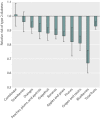Fruit consumption and risk of type 2 diabetes: results from three prospective longitudinal cohort studies
- PMID: 23990623
- PMCID: PMC3978819
- DOI: 10.1136/bmj.f5001
Fruit consumption and risk of type 2 diabetes: results from three prospective longitudinal cohort studies
Erratum in
- BMJ. 2013;347:f6935
Abstract
Objective: To determine whether individual fruits are differentially associated with risk of type 2 diabetes.
Design: Prospective longitudinal cohort study.
Setting: Health professionals in the United States.
Participants: 66,105 women from the Nurses' Health Study (1984-2008), 85,104 women from the Nurses' Health Study II (1991-2009), and 36,173 men from the Health Professionals Follow-up Study (1986-2008) who were free of major chronic diseases at baseline in these studies.
Main outcome measure: Incident cases of type 2 diabetes, identified through self report and confirmed by supplementary questionnaires.
Results: During 3,464,641 person years of follow-up, 12,198 participants developed type 2 diabetes. After adjustment for personal, lifestyle, and dietary risk factors of diabetes, the pooled hazard ratio of type 2 diabetes for every three servings/week of total whole fruit consumption was 0.98 (95% confidence interval 0.97 [corrected] to 0.99). With mutual adjustment of individual fruits, the pooled hazard ratios of type 2 diabetes for every three servings/week were 0.74 (0.66 to 0.83) for blueberries, 0.88 (0.83 to 0.93) for grapes and raisins, 0.89 (0.79 to 1.01) for prunes, 0.93 (0.90 to 0.96) for apples and pears, 0.95 (0.91 to 0.98) for bananas, 0.95 (0.91 to 0.99) for grapefruit, 0.97 (0.92 to 1.02) for peaches, plums, and apricots, 0.99 (0.95 to 1.03) for oranges, 1.03 (0.96 to 1.10) for strawberries, and 1.10 (1.02 to 1.18) for cantaloupe. The pooled hazard ratio for the same increment in fruit juice consumption was 1.08 (1.05 to 1.11). The associations with risk of type 2 diabetes differed significantly among individual fruits (P<0.001 in all cohorts).
Conclusion: Our findings suggest the presence of heterogeneity in the associations between individual fruit consumption and risk of type 2 diabetes. Greater consumption of specific whole fruits, particularly blueberries, grapes, and apples, is significantly associated with a lower risk of type 2 diabetes, whereas greater consumption of fruit juice is associated with a higher risk.
Conflict of interest statement
Competing interests: All authors have completed the ICMJE uniform disclosure form at
Figures
References
-
- World Health Organization. Promoting fruit and vegetable consumption around the world. 2003. www.who.int/dietphysicalactivity/fruit/en/index.html.
-
- Montonen J, Järvinen R, Heliövaara M, Reunanen A, Aromaa A, Knekt P. Food consumption and the incidence of type II diabetes mellitus. Eur J Clin Nutr 2005;59:441-8. - PubMed
Publication types
MeSH terms
Grants and funding
- CA167552/CA/NCI NIH HHS/United States
- R01 DK058845/DK/NIDDK NIH HHS/United States
- MC_UP_A100_1003/MRC_/Medical Research Council/United Kingdom
- R00HL098459/HL/NHLBI NIH HHS/United States
- UM1 CA176726/CA/NCI NIH HHS/United States
- CA55075/CA/NCI NIH HHS/United States
- T32 DK007703/DK/NIDDK NIH HHS/United States
- UM1 CA167552/CA/NCI NIH HHS/United States
- CA50385/CA/NCI NIH HHS/United States
- DK082486/DK/NIDDK NIH HHS/United States
- CA176726/CA/NCI NIH HHS/United States
- P01 CA055075/CA/NCI NIH HHS/United States
- R00 HL098459/HL/NHLBI NIH HHS/United States
- CA87969/CA/NCI NIH HHS/United States
- DK58845/DK/NIDDK NIH HHS/United States
- MC_UU_12015/5/MRC_/Medical Research Council/United Kingdom
- R01 DK082486/DK/NIDDK NIH HHS/United States
LinkOut - more resources
Full Text Sources
Other Literature Sources
Medical

